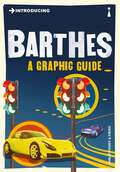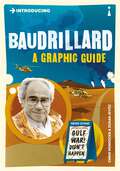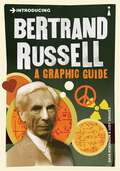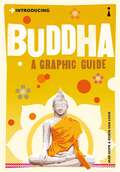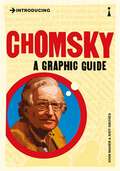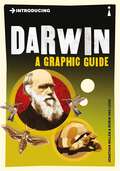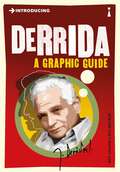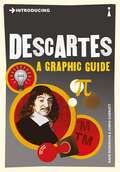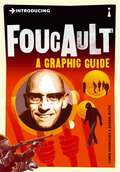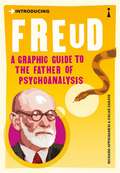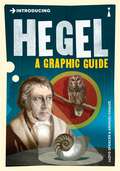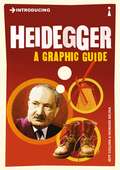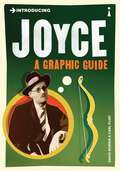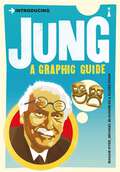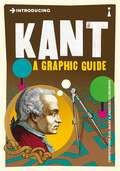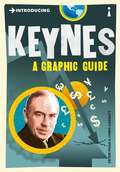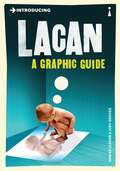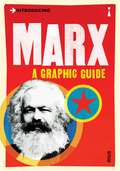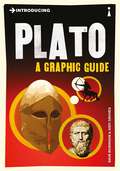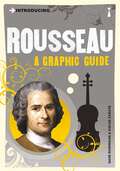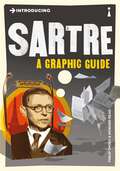- Table View
- List View
Introducing Barthes: A Graphic Guide (Introducing...)
by Philip ThodyINTRODUCING guide to the cult author, semiologist and analyzer of advertising, Roland Barthes. Roland Barthes is best known as a semiologist, a student of the science of signs. This sees human beings primarily as communicating animals, and looks at the way they use language, clothes, gestures, hair styles, visual images, shapes and colour to convey to one another their tastes, their emotions, their ideal self-image and the values of their society. Introducing Barthes brilliantly elucidates Barthes' application of these ideas to literature, popular culture, clothes and fashion, and explains why his thinking in this area made him a key figure in the structuralist movement of the 1960s. It goes on to describe how his later insistence on pleasure, the delights of sexual non-conformity, and the freedom of the reader to interpret literary texts in the light of ideologies such as existentialism, Marxism and Freudianism, as well as structuralism itself, continues to make him one of the most dynamic and challenging of modern writers. This is the perfect companion volume to Introducing Semiotics.
Introducing Baudrillard: A Graphic Guide (Introducing...)
by Chris HorrocksIllustrated guide to the controversial sociologist Jean Baudrillard, who died in 2007. Did the Gulf War take place? Is it possible to fake a bank robbery? Was sexual liberation a disaster? Jean Baudrillard has been hailed as one of France's most subtle and powerful theorists. But his provocative style and assaults on sociology, feminism and Marxism have exposed him to accusations of promoting a dangerous new orthodoxy - of being the 'pimp' of postmodernism. Introducing Baudrillard cuts beneath the controversy of this misunderstood intellectual to present his radical claims that reality has been replaced by a simulated world of images and events ranging from TV news to Disneyland. It provides a clear account of Baudrillard's work on obesity, pornography and terrorism and traces his development from critic of mass consumption to prophet of the apocalypse. Chris Horrocks' text and Zoran Jevtic?s artwork invite us to decide whether Baudrillard was a cure for the vertigo of contemporary culture - or one of its symptoms
Introducing Bertrand Russell: A Graphic Guide (Introducing...)
by Dave Robinson Judy GrovesBertrand Russell changed Western philosophy forever. He tackled many puzzles--how our minds work, how we experience the world, and what the true nature of meaning is. In "Introducing Bertrand Russell "we meet a passionate eccentric, active in world politics, who had outspoken views on sex, marriage, religion, and education.
Introducing Buddha: A Graphic Guide (Introducing...)
by Borin Van Loon Jane HopeMeditation, Karma, Zen, Tantric and Nirvana are some of the many Buddhist ideas Westerners hear of frequently, even if their meaning has been lost in translation. This vast and complex non-theistic religion is woven into the fabric of Asian civilisations. from India to the Himalayan regions, China, Vietnam, Korea, Japan and elsewhere. What is Buddhism really all about? Introducing Buddha describes the life and teachings of the Buddha, but it also shows that enlightenment is a matter of experiencing the truth individually, and by inspiration which is passed from teacher to student. Superbly illustrated by Borin Van Loon, the book illuminates this process through a rich legacy of stories, explains the practices of meditation, Taoism and Zen, and goes on to describe the role of Buddhism in modern Asia and its growing influence on Western thought.
Introducing Chomsky: A Graphic Guide (Introducing...)
by John MaherCan it be that the human brain possesses an in-built faculty for language? Noam Chomsky, one of the most brilliant linguists of the 20th century, believes that it does- that there exists a 'universal grammar' common to all languages. Around the world children learn, in very similar ways, languages that seem entirely different. This is possible, Chomsky argues, because all human languages and their grammatical structures are linked in the human brain. Chomsky is controversial and yet highly influential, both in his pioneering work in linguistics and in his unrelenting critique of international power and his commitment to freedom and justice. These two 'Chomskys' are heirs to the Enlightenment tradition, and this book is the ideal introduction to them both.
Introducing Darwin: A Graphic Guide (Introducing...)
by Jonathan MillerProgress in genetics today would not be possible without Darwin's revolution, but the mysterious man who laid the rational basis for undermining belief in God's creation was remarkable timid. He spent most of his life in seclusion; a semi-invalid, riddled with doubts, fearing the controversy his theories might unleash. In this brilliantly lucid book - a classic originally published in 1982 - Jonathan Miller unravels Darwin's life and his contribution to biology, and traces the path from his scientific predecessors to the later modifications that his own evolutionary theories required. Introducing Darwin brings alive the difficult progress from pre-Darwinian thinking to modern genetics and the devastatingly important impact of one man on our fundamental understanding of biology, life and ourselves.
Introducing Derrida: A Graphic Guide (Introducing... #0)
by Jeff CollinsBrilliant illustrated guide to the best-known and most controversial continental philosopher of the latter 20th century. Jacques Derrida is the most famous philosopher of the late 20th century. Yet Derrida has undermined the rules of philosophy, rejected its methods, broken its procedures and contaminated it with literary styles of writing. Derrida's philosophy is a puzzling array of oblique, deviant and yet rigorous tactics for destabilizing texts, meanings and identities. 'Deconstruction', as these strategies have been called, is reviled and celebrated in equal measure. Introducing Derrida introduces and explains his work, taking us on an intellectual adventure that disturbs some of our most comfortable habits of thought.
Introducing Descartes: A Graphic Guide (Introducing... Ser.)
by Dave RobinsonRené Descartes is famous as the philosopher who was prepared to doubt everything- even his own physical existence. Most people also know that he said 'I think, therefore I am', even if they are not always sure what he really meant by it. Introducing Descartes explains what Descartes doubted, and why he is usually called the father of modern philosophy. It is a clear and accessible guide to all the puzzling questions he asked about human beings and their place in the world. Dave Robinson and Chris Garratt give a lucid account of Descartes' contributions to modern science, mathematics, and the philosophy of mind- and also reveal why he liked to do all of his serious thinking in bed.
Introducing Foucault: A Graphic Guide (Introducing...)
by Chris HorrocksMichel Foucault's work was described at his death as 'the most important event of thought in our century'. As a philosopher, historian and political activist, he certainly left behind an enduring and influential body of work, but is this acclaim justified? "Introducing Foucault" places his work in its turbulent philosophical and political context, and critically explores his mission to expose the links between knowledge and power in the human sciences, their discourses and institutions. This book explains how Foucault overturned our assumptions about the experience and perception of madness, sexuality and criminality, and the often brutal social practices of confinement, confession and discipline. It also describes Foucault's engagement with psychiatry and clinical medicine, his political activism and the transgressive aspects of pleasure and desire that he promoted in his writing.
Introducing Freud: A Graphic Guide (Introducing...)
by Richard Appignanesi Oscar ZarateFreud revolutionized the way we think about ourselves. His psychoanalytic terms such as Id, Ego, libido, neurosis and Oedipus Complex have become a part of our everyday vocabulary. But do we know what they really mean? Introducing Freud successfully demystifies the facts of Freud's discovery of psychoanalysis. Irreverent and witty but never trivial, the book tells the story of Freud's life and ideas from his upbringing in 19th-century Vienna, his early medical career and his encounter with cocaine, to the gradual evolution of his theories on the unconscious, dreams and sexuality. With its combination of brilliantly clever artwork and incisive text, this book has achieved international success as one of the most entertaining and informative introductions to the father of psychoanalysis.
Introducing Hegel: A Graphic Guide (Introducing...)
by Lloyd SpencerINTRODUCING guide to the hugely influential German thinker. Georg Wilhelm Friedrich Hegel is one of the greatest thinkers of all time. No other philosopher has had such a profound impact on the ideas and political events of the 20th century. Hegel's influential writings on philosophy, politics, history and art are parts of a larger systematic whole. They are also among the most difficult in the entire literature of philosophy. Introducing Hegel guides us through a spectacular system of thought which aimed to make sense of history. The book also provides new perspectives on contemporary postmodern debates about 'metanarratives' (Lyotard) and the 'end of history' (Fukuyama). It is an ideal introduction to this crucial figure in the history of philosophy, and is indispensable for anyone trying to understand such key modern thinkers as Marx, Lacan, Satre and Adorno.
Introducing Heidegger: A Graphic Guide (Introducing...)
by Jeff CollinsMartin Heidegger - philosophy's 'hidden king', or leading exponent of a dangerously misguided secular mysticism. Heidegger has been acclaimed as the most powerfully original philosopher of the twentieth century. Profoundly influential on deconstruction, existentialism and phenomenology, he stands behind all major strands of post-structuralist and postmodern thought. Heidegger announced the end of philosophy and of humanism, and was a committed Nazi and vocal supporter of Hitler's National Socialism. Was Heidegger offering a deeply conservative mythology or a crucial deconstruction of philosophy as we have known it? "Introducing Heidegger" provides an accessible introduction to his notoriously abstruse thinking, mapping out its historical contexts and exploring its resonances in ecology, theology, art, architecture, literature and other fields. The book opens up an encounter with a kind of thinking whose outlines might still not yet be clear, and whose forms might still surprise us.
Introducing Jesus: A Graphic Guide (Introducing...)
by Anthony O'HearChristianity depends on the belief that the Jesus of history is identical with the Christ of faith, and that God in the person of Jesus intervened finally and decisively in human history. But is the historical Jesus the same as the Christian Saviour? And how did an obscure provincial religion based on the paradox of a crucified saviour conquer the Roman Empire and outlive it? INTRODUCING JESUS - A GRAPHIC GUIDE confronts the enigmas. It sets Jesus in the perspective of his time - within Judaism and its expectations of a Messiah, in the atmosphere of Greek philosophy and the Roman deification of emperors. It traces the development of Christianity from St. Paul and the Romanization of the Church, to modern liberation theology. This book is a lucid and exciting investigation that will appeal to all readers, whether Christian or not.
Introducing Joyce: A Graphic Guide (Introducing...)
by David NorrisJames Joyce is one of the most famous--and controversial--writers of the twentieth century. The myth of his difficulty has discouraged many readers from works such as "Ulysses," but David Norris explores his life and work in this engaging and intellectually rigorous introduction.
Introducing Jung: A Graphic Guide (Introducing... Ser.)
by Maggie Hyde'Clever and witty.' Susie Orbach, Guardian Carl Gustav Jung was the enigmatic and controversial father of analytical psychology. This updated edition of Introducing Jung brilliantly explains the theories that underpin Jung’s work, delves into the controversies that led him to break away from Freud and describes his near psychotic breakdown, from which he emerged with radical new insights into the nature of the unconscious mind – and which were published for the first time in 2009 in The Red Book. Step by step, Maggie Hyde demonstrates how it was entirely logical for him to explore the psychology of religion, alchemy, astrology, the I Ching and other phenomena rejected by science in his investigation of his patients’ dreams, fantasies and psychic disturbances.
Introducing Kant: A Graphic Guide (Introducing...)
by Christopher Kul-WantIllustrated INTRODUCING guide to the pre-eminent philosopher of the Enlightenment. Immanuel Kant laid the foundations of modern Western thought. Every subsequent major philosopher owes a profound debt to Kant?s attempts to delimit human reason as an appropriate object of philosophical enquiry. And yet, Kant's relentless systematic formalism made him a controversial figure in the history of the philosophy that he helped to shape. Introducing Kant focuses on the three critiques of Pure Reason, Practical Reason and Judgement. It describes Kant's main formal concepts: the relation of mind to sensory experience, the question of freedom and the law and, above all, the revaluation of metaphysics. Kant emerges as a diehard rationalist yet also a Romantic, deeply committed to the power of the sublime to transform experience. The book explores the paradoxical nature of his ideas and explains the reasons for his undiminished importance in contemporary philosophical debates.
Introducing Keynes: A Graphic Guide (Introducing... Ser.)
by Peter PughAs we find ourselves at the cusp of an economic downturn, there has been a clear reinvigoration of Keynesian economics as governments are attempting to stimulate the market through public funds. Forming his economic theories in the wake of the Great Depression, John Maynard Keynes argued that a healthy economy depended on the total spending of consumers, business investors and, most importantly, governments too. Keynes formulated that governments should take control of the economy in the short term, rather than relying on the market, because, as he eloquently put it 'in the long run, we are all dead'. This graphic guide is the ideal introduction to one of the most influential economists of the 20th century, at a time when his theories may be crucial to our economic survival. Through a deft mixture of words and images, "Introducing Keynes" is a timely, accessible and enjoyable read.
Introducing Lacan: A Graphic Guide (Introducing...)
by Darian LeaderJacques Lacan is now regarded as a major psychoanalytical theorist alongside Freud and Jung, although recognition has been delayed by fierce arguments over his ideas. Written by a leading Lacanian analyst, "Introducing Lacan" guides the reader through his innovations, including his work on paranoia, his addition of structural linguistics to Freudianism and his ideas on the infant 'mirror phase'. It also traces Lacan's influence in postmodern critical thinking on art, literature, philosophy and feminism. This is the ideal introduction for anyone intrigued by Lacan's ideas but discouraged by the complexity of his writings.
Introducing Machiavelli: A Graphic Guide (Introducing...)
by Patrick CurryIllustrated guide to the crucial Italian philosopher and author of The Prince. 'Machiavellian' is a popular byword for treachery and opportunism. Machiavelli's classic book on statecraft, The Prince, published over 400 years ago, remains controversial to this day because of its electrifying frankness as a practical guide to power. Is it a how-to manual for dictators, a cynical philosophy of 'the end justifies the means', or a more complex and subtle analysis of successful government? Machiavelli was a loyal servant of the Florentine republic. His opposition to Medici despotism led him to torture on the rack and exile, and yet he chose as his model for the Prince the most notorious tyrant, Cesare Borgia. Introducing Machiavelli traces the colourful life of this paradoxical realist whose clear-sighted patriotism made him the first truly modern political scientist. Machiavelli is seen as central to the postmodern debate on Civil Society. This book brings the creative turbulence of Renaissance Italy to life, and presents a compelling portrait of a key figure of European political history.
Introducing Marx: A Graphic Guide (Introducing...)
by RiusCompact INTRODUCING guide to the influential philosopher, sociologist and economist. INTRODUCING MARX - A GRAPHIC GUIDE explores the life of the most famous Socialist figure, from his early years to meeting Engels in1842. It provides a readable, understandable biography of Karl Marx as well as a fundamental account of his original philosophy, its roots in 19th century European ideology, his radical economic and social criticism of capitalism that inspired vast 20th century revolutions.
Introducing Melanie Klein: A Graphic Guide (Introducing...)
by R. D. Hinshelwood Susan RobinsonINTRODUCING guide to the pioneering child psychoanalyst. Born in Vienna in 1882, Melanie Klein became a pioneer in child psychoanalysis and developed several ground-breaking concepts about the nature and crucial importance of the early stages of infantile development. Although she was a devoted Freudian, many of her ideas were seen within the psychoanalytic movement as highly controversial, and this led to heated conflicts, particularly with Freud's daughter, Anna. Introducing Melanie Klein brilliantly explains Klein's ideas, and shows the importance of her startling discoveries which raised such opposition at the time and are only now being recognized for their explanatory power. Her concepts of the depressive position and the paranoid-schizoid position are now in common usage and her work has to be taken seriously by psychoanalysts the world over. She is also now important in many academic fields within the human sciences.
Introducing Nietzsche: A Graphic Guide (Introducing... #0)
by Laurence Gane PieroWhy must we believe that God is dead? Can we accept that traditional morality is just a 'useful mistake'? Did the principle of 'the will to power' lead to the Holocaust? What are the limitations of scientific knowledge? Is human evolution complete or only beginning? It is difficult to overestimate the importance of Friedrich Nietzsche for our present epoch. His extraordinary insights into human psychology, morality, religion and power seem quite clairvoyant today: existentialism, psychoanalysis, semiotics and postmodernism are plainly anticipated in his writings - which are famously enigmatic and often contradictory."Introducing Nietzsche" is the perfect guide to this exhilarating and oft-misunderstood philosopher.
Introducing Plato: A Graphic Guide (Introducing... #0)
by Dave Robinson"Introducing Plato" begins by explaining how philosophers like Socrates and Pythagoras influenced Plato's thought. It provides a clear account of Plato's puzzling theory of knowledge, and explains how this theory then directed his provocative views on politics, ethics and individual liberty. It offers detailed critical commentaries on all of the key doctrines of Platonism, especially the very odd theory of Forms, and concludes by revealing how Plato's philosophy stimulated the work of important modern thinkers such as Karl Popper, Martha Nussbaum, and Jacques Derrida.
Introducing Rousseau: A Graphic Guide (Introducing...)
by Dave RobinsonIllustrated guide to the crucial French philosopher who denied bring a philosopher at all. 'I am like no one else in the whole world ...' Thus begins Jean-Jacques Rousseau's defiant Confessions - an autobiography of astounding psychological insight. Musician, poet, novelist and botanist, but above all, a philosopher who firmly denied being one, Rousseau was the first to ask: "What is the value of civilization?" His answer - that civilization corrupts natural goodness and increases social inequalities - shocked his Enlightenment contemporaries and still challenges us today. Did Rousseau inspire the French Revolution? Can Romanticism, psychoanalysis and Existentialism all be traced back to him? Introducing Rousseau presents a maverick thinker whose ideas revolutionized our understanding of childhood, education, government, language and much else. Dave Robinson's clear and concise account of Rousseau's ideas, engagingly dramatized by Oscar Zarate's illustrations, guides the reader through Rousseau's turbulent life of lost innocence, persecution and paranoia.
Introducing Sartre: A Graphic Guide (Introducing...)
by Philip ThodyINTRODUCING guide to the father of existentialism and one of 20th century philosophy's most famous characters. Jean-Paul Sartre was once described as being, next to Charles de Gaulle, the most famous Frenchman of the 20th century. Between the ending of the Second World War in 1945 and his death in 1980, Sartre was certainly the most famous French writer, as well as one of the best-known living philosophers. Introducing Sartre explains the basic ideas inspiring his world view, and pays particular attention to his idea of freedom. It also places his thinking on literature in the context of the 20th century debate on its nature and function. It examines his ideas on Marxism, his enthusiasm for the student rebellion of 1968, and his support for movements of national liberation in the Third World. The book also provides a succinct account of his life, and especially of the impact which his unusual childhood had on his attitude towards French society.
